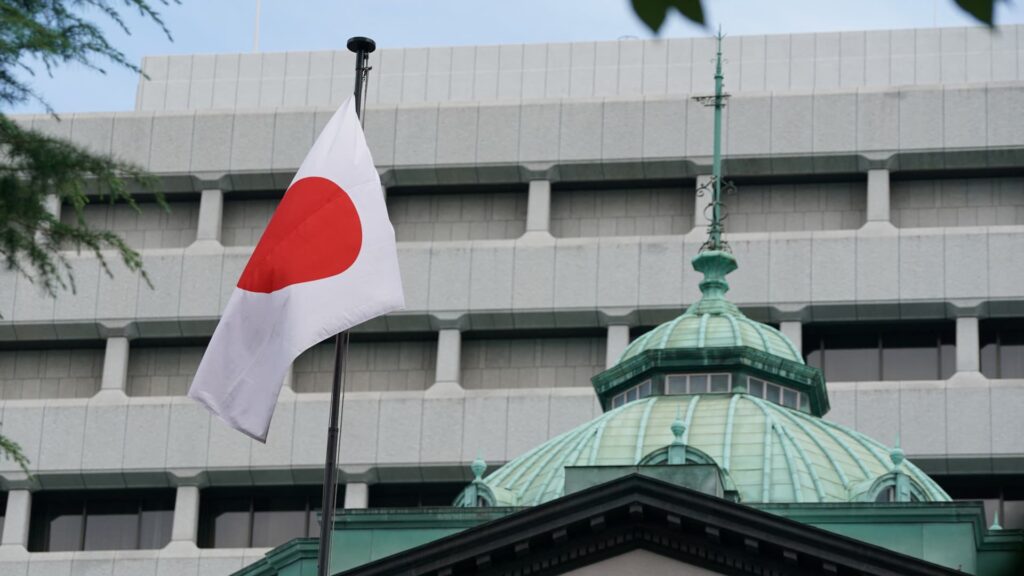On July 31, 2024, the Japanese flag was raised at the Bank of Japan’s (Bank of Japan) head office in Tokyo. The Bank of Japan took another step away from its massive monetary easing program, raising its key interest rate on July 31 for the second time in 17 years.
Kazuhiro Nogi | AFP | Getty Images
Japan’s central bank kept its benchmark interest rate unchanged at 0.5% on Thursday at Sanae Takaichi’s first meeting since taking office as prime minister earlier this month.
The decision was in line with forecasts from economists polled by Reuters and comes as inflation has remained above the central bank’s 2% target for 41 consecutive months.
According to the Bank of Japan, the decision was split 7-2, with board members Naoki Tamura and Hajime Takada proposing a 25 basis point (bp) rate hike.
Market reaction to the expected decision was relatively muted, with Japan’s 10-year bond yield little changed, the yen down 0.2% to 153.03 yen, and the Nikkei Stock Average up 0.4%.
Krishna Bhimavarapu, Asia-Pacific economist at State Street Investment Management, said in a note after the decision that a better assessment of global trade-related volatility would “increase the likelihood” of a rate hike within the next two policy meetings.
“Nonetheless, the Bank is likely to continue to move only slowly next year,” he added.

The Bank of Japan’s ruling came as U.S. Treasury Secretary Scott Bessent met on Monday with Satsuki Katayama, the new finance minister in Takaichi’s administration, and appeared to target Tokyo over the weak yen, as well as commenting on Japan’s monetary policy.
The U.S. Treasury Department said in a statement Tuesday that Bessent “stressed the critical role of sound monetary policy development and communication in anchoring inflation expectations and preventing excessive exchange rate volatility.”
Higher interest rates tend to attract foreign inflows and make the currency stronger, while lower interest rates tend to weaken the currency.
The weak yen has become a thorn in the side of U.S. President Donald Trump, who said in March that Tokyo had induced the currency to weaken to gain an unfair trade advantage.
President Trump met with Takaichi, who advocates lowering interest rates and has called the Bank of Japan’s interest rate hikes “stupid” in the past.
Although Mr. Takaichi appears to have softened his stance, this promotion of a strong yen remains at odds with his plans for large-scale fiscal stimulus and monetary easing.
“The most important thing is for the Bank of Japan and the government to coordinate their policies and communicate closely,” Takaichi said on October 21, according to Reuters.
Takaichi is seen as a supporter of the late Shinzo Abe’s economic strategy, “Abenomics,” which promoted monetary easing, fiscal spending, and structural reforms.
“The government’s stance of allowing the Bank of Japan policy space is key to entrenching inflation expectations,” Bessent wrote in X magazine on Wednesday.
Katayama said in March that the real value of the yen is likely to be around 120-130 yen against the dollar, about 26% higher than the current level of around 152 yen.
Experts say Mr. Takaichi’s policies are likely to devalue the yen, something that is already happening in the so-called “Takaichi trade.” Nikkei Stock Average The yen has fallen to record levels, with the yen depreciating by more than 150 yen against the dollar.
The Bank of Japan’s decision is also based on the relatively weak export situation. Japan’s exports fell for four consecutive months and recovered in September, but shipments to the United States are still declining.

